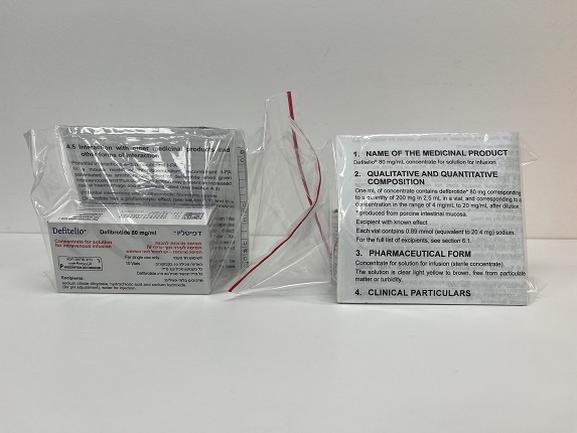Quest for the right Drug

דפיטליו DEFITELIO (DEFIBROTIDE)
תרופה במרשם
תרופה בסל
נרקוטיקה
ציטוטוקסיקה
צורת מתן:
תוך-ורידי : I.V
צורת מינון:
תרכיז להכנת תמיסה לאינפוזיה : CONCENTRATE FOR SOLUTION FOR INFUSION
עלון לרופא
מינוניםPosology התוויות
Indications תופעות לוואי
Adverse reactions התוויות נגד
Contraindications אינטראקציות
Interactions מינון יתר
Overdose הריון/הנקה
Pregnancy & Lactation אוכלוסיות מיוחדות
Special populations תכונות פרמקולוגיות
Pharmacological properties מידע רוקחי
Pharmaceutical particulars אזהרת שימוש
Special Warning עלון לרופא
Physicians Leaflet
Adverse reactions : תופעות לוואי
4.8 Undesirable effects Summary of the safety profile The safety evaluation of defibrotide is based on the safety pooled data set, which included patients who received 25 mg/kg/day of defibrotide for the treatment of VOD, from 4 clinical studies: The Phase 3 pivotal treatment study (2005-01), the Treatment-IND study, the dose-finding study (99-118), and a controlled randomised prophylaxis study (2004-000592-33). In the Phase 3 pivotal treatment study, the overall incidence of adverse events was similar in the defibrotide treatment group and in the control group (historical). The tabulated list of adverse reactions incorporates the ADRs observed in the safety pooled data set [ADR = any event reported as possibly related on at least two occasions] and TEAEs observed in the final completed Treatment-IND 2006-05 study [TEAE = any AE that started or worsened in severity after the first dose of defibrotide]. For the adverse reactions reported, the highest frequency was used in the table below. The safety data from the pivotal study are supported and confirmed with data from the completed Treatment-IND study. The most frequent adverse reactions observed during the treatment of hepatic VOD are haemorrhage (including but not limited to gastrointestinal haemorrhage, pulmonary haemorrhage and epistaxis) and hypotension. In addition, although in the defibrotide studies in VOD there have been no reports of hypersensitivity, cases of hypersensitivity including anaphylaxis were reported from a previously marketed formulation of defibrotide, consequently hypersensitivity is included as an ADR. Tabulated list of adverse reactions Adverse reactions observed are listed below, by system organ class and frequency. Within each frequency grouping, undesirable effects are presented in order of decreasing seriousness. Frequencies are defined as: very common (≥1/10), common (≥1/100 to <1/10), uncommon (≥1/1,000 to <1/100), rare (≥1/10,000 to <1/1,000), very rare (<1/10,000). Blood and lymphatic system disorders Common Coagulopathy Immune system disorders Uncommon Hypersensitivity Anaphylactic reaction Nervous system disorders Common Cerebral haemorrhage Uncommon Cerebral haematoma Eye disorders Uncommon Conjunctival haemorrhage Vascular disorders Very common Hypotension Common Haemorrhage Respiratory, thoracic and mediastinal disorders Common Pulmonary haemorrhage Epistaxis Uncommon Haemothorax Gastrointestinal disorders Common Gastrointestinal haemorrhage Vomiting Diarrhoea Nausea Haematemesis Mouth haemorrhage Uncommon Melaena Skin and subcutaneous tissue disorders Common Rash Pruritus Petechiae Uncommon Ecchymosis Renal and urinary disorders Common Haematuria General disorders and administration site conditions Common Catheter site haemorrhage Pyrexia Uncommon Injection site haemorrhage Paediatric population In the treatment studies over 50% of the patients were children. In doses above the recommended dose of 25 mg/kg/day there was a higher proportion of patients with bleeding events in the high dose group but since many events occurred in the follow-up period, a clear relationship with defibrotide treatment could not be determined. In the paediatric prevention study at 25 mg/kg/day there was an increased incidence of any bleeding events in the defibrotide group compared with the treatment group. However there was no difference in incidence of serious bleeding or bleeding events with fatal outcome. The frequency nature and severity of adverse reactions in children are otherwise the same as in adults. No special precautions are indicated. Reporting of suspected adverse reactions Reporting suspected adverse reactions after authorisation of the medicinal product is important. It allows continued monitoring of the benefit/risk balance of the medicinal product. Any suspected adverse events should be reported to the Ministry of Health according to the National Regulation by using an online form https://sideeffects.health.gov.il.

פרטי מסגרת הכללה בסל
התרופה תינתן לחולים שעברו השתלת מח עצם (HSCT) ופיתחו מחלה חסימתית של ורידי הכבד(VOD – veno occlusive disease) בדרגת חומרה קשה (severe) (דרגת חומרה תוגדר על פי הנחיותקליניות מקובלות).
שימוש לפי פנקס קופ''ח כללית 1994
לא צוין
תאריך הכללה מקורי בסל
15/01/2015
הגבלות
תרופה מוגבלת לרישום ע'י רופא מומחה או הגבלה אחרת
מידע נוסף
